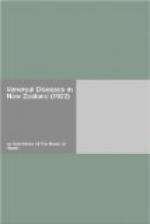This question obviously presents more difficulty than that of notification, but it is clear that unless some means are provided of bringing under treatment and, if necessary, isolating persons who are suffering from highly contagious diseases, and who will not avail themselves of medical treatment although this is provided free of cost by the State, and who are knowingly or recklessly communicating the disease to others, it will be impossible to keep in check this terrible scourge. Without such provision any abandoned woman, as in case 4, or any male libertine, may continue to sow disease broadcast without any power to stop them. Failing some such measure, table articles and food may continue to be smeared by hands soiled with syphilitic material, as in case 1; section 6 of the Social Hygiene Act remains mere useless verbiage, and the infecting of innocents, as in case 3, may continue unchecked.
Legislation dealing with this subject needs to be carefully framed with suitable safeguards, but the Committee think that an amendment of the Social Hygiene Act on the lines proposed by the Department of Health should be adopted. These provisions are:—
(1.) That whenever the Director-General of Health has reason to believe that any person is suffering from venereal disease, and has infected or is liable to infect other persons, he may give notice in writing to such person directing him to consult a medical practitioner, and to produce within a time specified in the notice a certificate from such medical practitioner to the satisfaction of the Director-General of Health that such person is or is not suffering from venereal disease.
(2.) Should the person not comply with this request, the Director-General of Health may obtain a warrant from a Magistrate ordering such person to undergo examination to prove the existence, or non-existence, of venereal disease.
(3.) Making it possible for a Magistrate, on the application of the Director-General of Health, to order the detention in a hospital or other approved place of a person who is likely to be a danger to other persons until that person is cured of venereal disease.
These provisions are applicable equally to both sexes, and the Committee see no reason to fear that the law would not be carefully and impartially administered. If it should appear that more women than men came under the operation of the law this result would be due to the fact that, as disclosed in the evidence, a much larger proportion of women than men fail to seek treatment, and of those treated a much larger proportion of women fail to continue treatment until no longer infectious.
It is hardly conceivable that a responsible officer, such as the Director-General of Health, would take action under these provisions unless he had strong reason to believe that such action was justified. But, even if he makes a mistake or is misinformed, the worst that can happen to an innocent person wrongfully suspected is that he or she will be required to produce a medical certificate, which can be procured free of cost from any hospital or V.D. clinic. This is wholly different from the provisions of the Contagious Diseases Act, under which a woman suspected of prostitution was liable to be arrested by a constable in the street.




